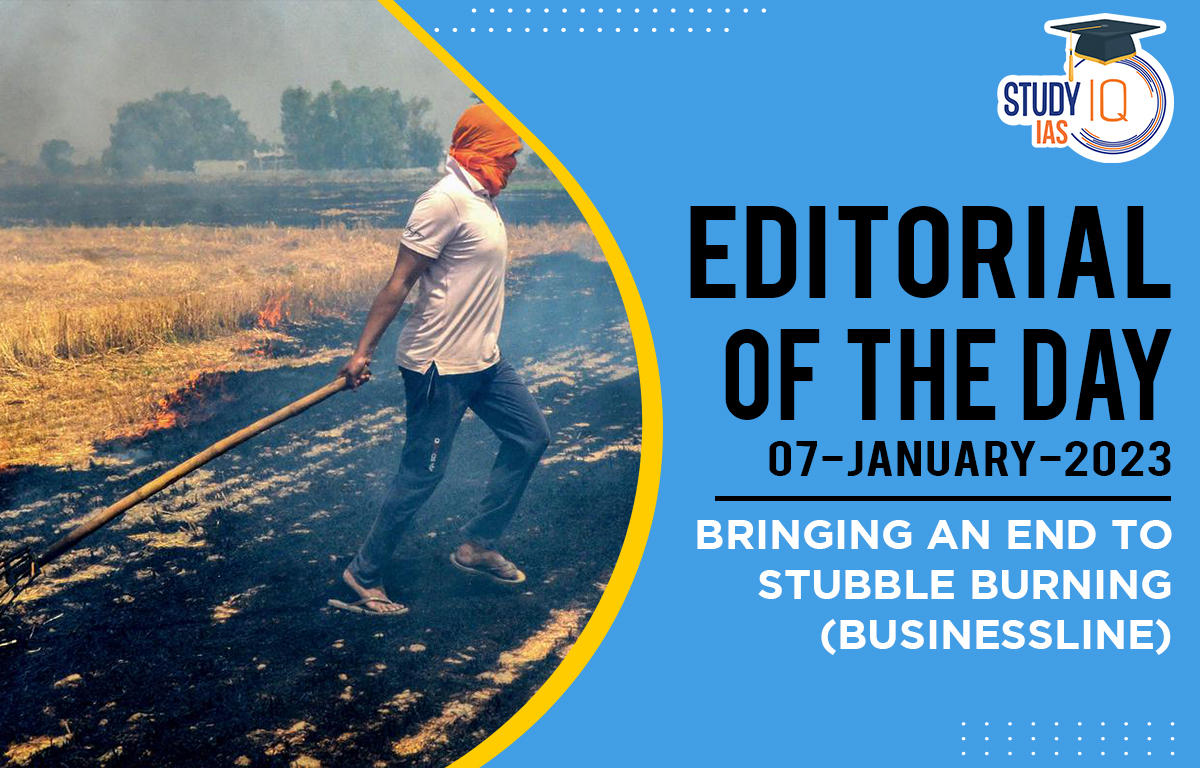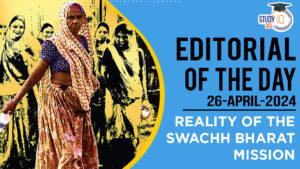Table of Contents
Exam View: Stubble burning, Air pollution in Northern India, Subsidies for electricity and fertilisers, Happy Seeder, Bioethanol, Pusa Basmati-1509, Major problems of Stubble Burning, Alternatives to Stubble Burning.
In News: Stubble burning across Delhi, NCR particularly by farmers in north India is seen as a major cause of air pollution in Delhi.
- Stubble burning is a practice of removing agricultural waste from the field by setting on fire the straw stubble (parali) that is left on the land after harvesting of grains like paddy, wheat etc in order to prepare it for the next round of seeding.
- Every year, stubble burning peaks during the onset of winter around October- November as this is the harvesting period of paddy crops and the residue left behind needs to be cleared to sow wheat. Each year, air pollution levels rise, and air quality index reaches a ‘severe’ and ‘hazarduous’ level.
Reasons for Stubble Burning
- The main problem behind crop burning is the rotational cropping system of rice and wheat where farmers burn stubble as they have to quickly clear the fields for the next crop.
- Due to a shortage of labour and time, when paddy is harvested by a combined harvester and thresher, particularly by large farmers in Punjab, the machine leaves behind a significant length of straw and stubble on the field.
- This prevents other machines from sowing wheat seeds and thus farmers often burn the stubble to quickly eliminate the paddy stubble.

Major Problems of Stubble Burning
- Global warming: The major problems of the burning of crop residues are pollution and greenhouse gas emissions that lead to global warming.
- Burning stubble emits toxic gases such as Carbon Monoxide (CO), Methane (CH4), Polycyclic Aromatic Hydrocarbons (PAH), and Volatile Organic Compounds (VOC).
- These directly contribute to environmental pollution and are also responsible for the haze in Delhi and the melting of Himalayan glaciers.
- Insufficient Stubble Management Infrastructure: Farmers burned almost 15.4 million metric tons (out of 19.7 MMT) in open fields due to the lack of stubble management infrastructure (Punjab government 2017).
- Impacts on Human Health: There have been several health effects caused by the resultant air pollution, ranging from skin irritation to severe neurological, cardiovascular, and respiratory problems.
- Research shows that pollution exposure also has an adverse effect on mortality rates – the life expectancy of Delhi residents has decreased by about 6.4 years as a result of high pollution levels.

- Kills essential for soil fertility: Soil degradation is another problem due to the burning of crop residues. Burning paddy straw radiates heat that kills fungus and bacteria which is essential for soil fertility.
- Cheaper and faster: Also, it is preferred by farmers because it is cheaper and faster, helping them to clear the land in time for the next cropping season.
- Negative Effects of Subsidies for Agriculture: Subsidies for electricity and fertilisers, along with easier access to credit in agriculture, have led to substantial increases in crop yields and agricultural productivity in subsequent decades, which has in turn exacerbated stubble burning.

Alternatives to Stubble Burning
- Innovative farm technologies: One of the recent innovations that could help farmers to manage crop residues effectively is by employing agricultural machines like Happy seeder, Rotavator, Baler, Paddy straw chopper, etc. but these machines are too costly. Therefore, the government should provide adequate subsidies to make this machinery affordable for farmers.
- New and Improved seed varieties: The use of new and improved varieties of rice and wheat crops particularly short-duration crop varieties like Pusa Basmati-1509 and PR-126, could be seen as a measure to overcome the problem of stubble burning as they mature quickly and also improve the quality of the soil.
- Bio Enzyme-PUSA: A bio-enzyme called PUSA has been developed by the Indian Agriculture Research Institute as a solution to stubble burning.
- As soon as it is sprayed, this enzyme starts decomposing the stubble in 20-25 days, turning it into manure, which further improves the soil.
- In-situ treatment of stubble: Providing equipment to farmers to mix the stubble back into the soil, so that they do not have to burn it.
- Ex-situ treatment: Under this, some companies have started collecting stubble for their use, but we need more action on this front.
- Changing cropping pattern: It is the deeper and more fundamental solution.
- Subsidise crops other than paddy, the source of most stubble burning. Policy and money should incentivise farmers in the region to plant more fruits and vegetables.
- Happy Seeder: Instead of burning the stubble, a tractor-mounted machine called the Happy Seeder can be used that “cuts and lifts rice straw, sows’ wheat into the bare soil, and deposits the straw over the sown area as mulch.
- Palletisation: Paddy straw can be dried and converted into pellets that can be mixed along with coal which can be used in thermal power plants and industries as fuel. This can save coal as well as reduce carbon emissions.
- Sustainable farm management practices: Other measures suggested by agriculturists and scientists include composting, production of biochar, and in-situ management with mechanical intensification.
- Educating and empowering the stakeholders: Educating and empowering the farming community could be an important step to making a significant impact.
- Additional Alternative Uses: Stubbles can be used in various ways; cattle feed, compost manure, roofing in rural areas, packing materials, for preparation of papers, and for preparation of bioethanol as well.
- The solution to the problem of stubble burning lies in exploring sustainable farm practices with an active role of the government in regulation and framing policies.
- In recent years, the government has developed a framework and action plan for effective prevention and control of stubble burning. But a major challenge that lies with these schemes is their successful implementation and enforcement.
- The government should act as an enabler by spreading awareness about the pros and cons of each option, so as to eliminate confusion and ease the adoption of new technologies by removing socio-economic barriers so that these new and innovative technologies can be accessed by small and marginal farmers.
- All these efforts could help in providing support to the farmer and could be effective in controlling stubble burning along with environmental pollution in the country.


 Current Affairs 26th April 2024 for UPSC...
Current Affairs 26th April 2024 for UPSC...
 Editorial of the day (26th Apr): Reality...
Editorial of the day (26th Apr): Reality...
 India And G7, India has Received Invitat...
India And G7, India has Received Invitat...

















